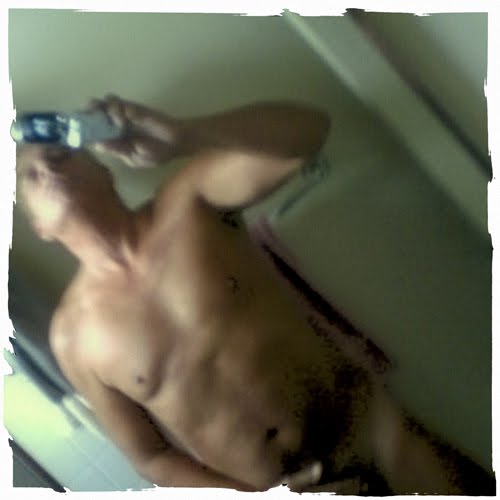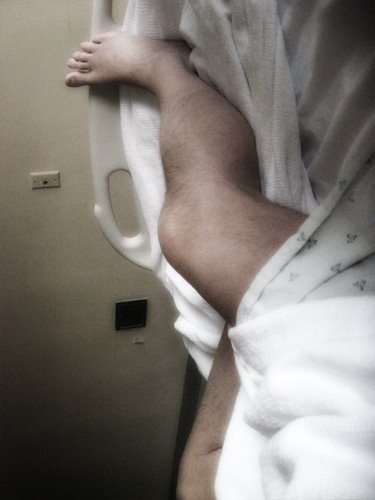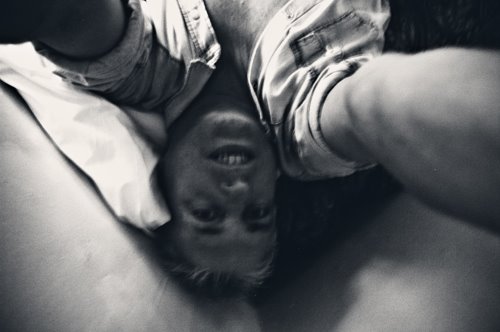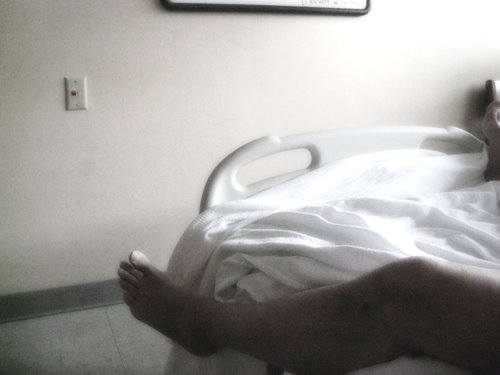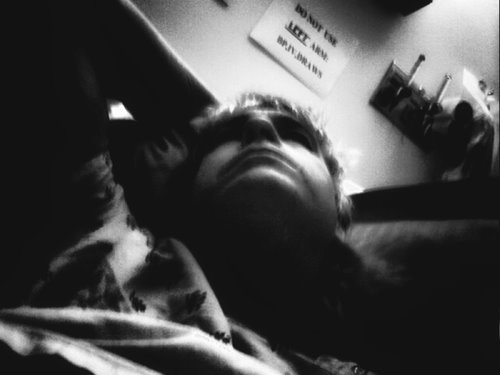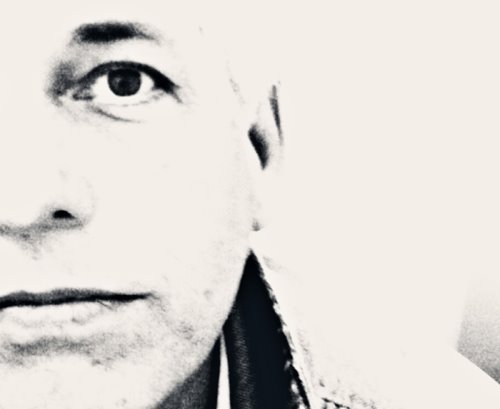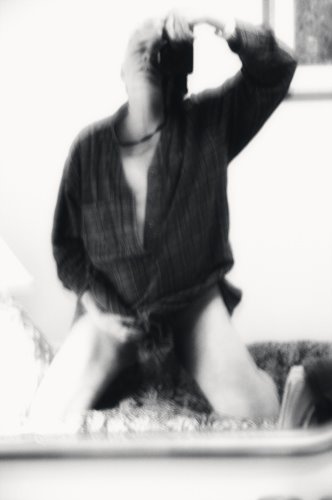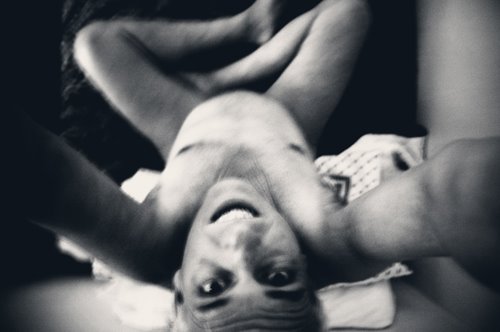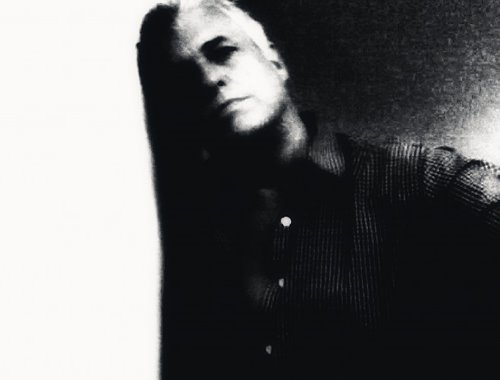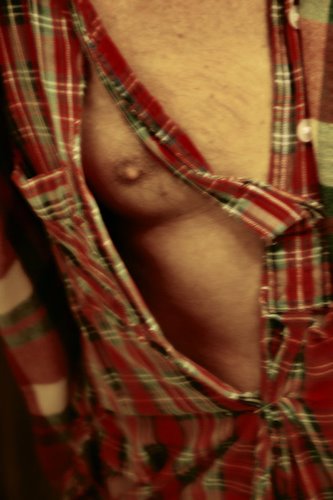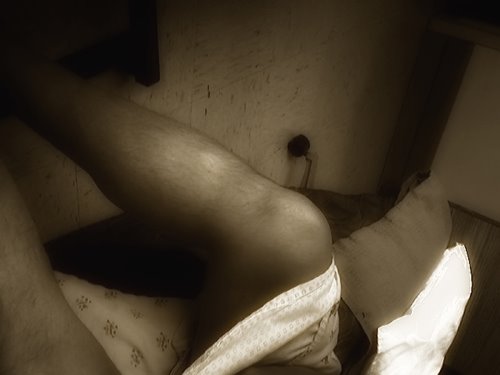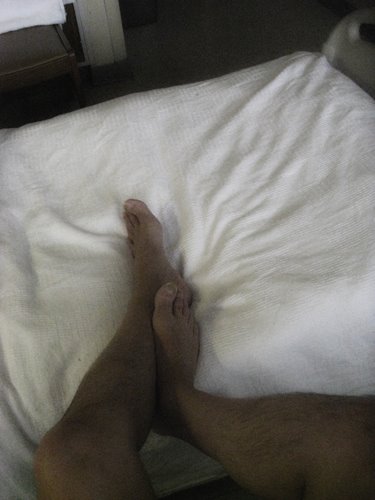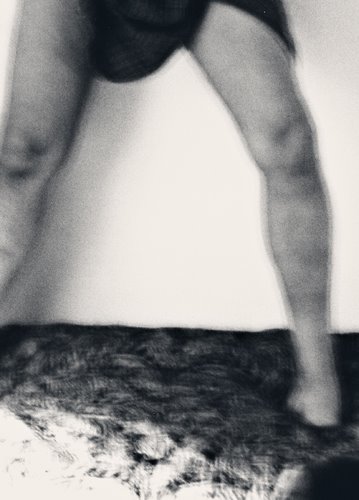Except for the one photo in the coffee shop, these are all people walking on the same street, or crossing the same street, or close to the same corner, or whatever. And the coffee shop is near that corner. (Number 1)
(Number 2) I wish you could hear the music I'm listening to when I'm working on these photos because it makes a difference to me to work with music, with jazz. It inspires me to do certain things with the photos, or at least it inspires me to choose one photo or a set of photos to work with over another photo or set of photos on a particular day. Today, this morning, I'm listening to the Ornette Coleman Quartet, 1960....a CD called "Change of the Century" with Charlie Haden bass, Don Cherry pocket trumpet and Billy Higgins drums. One of the best examples of the direction jazz was beginning to take at the beginning of 1960, and Ornette Coleman was at the forefront of what would be called "avant garde" jazz. This was before Coltrane pulled out ahead of everybody, but Ornette Coleman is still alive today and is still far ahead of most jazz musicians when it comes to changes in direction, free form jazz composition and improvization. This CD, "Change of the Century" is one of the best demonstrations of Charlie Haden's genius and Billy Higgin's playing set a new direction for jazz drumming. If you havent heard this stuff, by all means get the CD, download it to iTunes ASAP. (Number 3)
(Number 4) "On the Road" was published in 1957, three years before this session was recorded. The "beat generation" got into its movement between 1957 and 1969, when Kerouac died. In 1959 Ornette signed with Atlantic Records and recorded a series of albums that would redefine jazz the way Kerouac and "beat" writers and poets would redefine and distinguish a new generation, before Bukowski redefined it even further, without metaphors! "Tomorrow Is the Question" came out in 1959, "The Shape of Jazz to Come" came next and in 1960 he recorded the album "Free Jazz: A Collective Improvization", which was a double quartet (4+4), featuring his regular group plus a second group with Freedie Hubbard, Eric Dolphy, Scott LaFaro and Ed Blackwell. In 1969 he was inducted into the Down Beat Jazz Hall of Fame. While this was going on, Lenny Bruce was performing in San Francisco in the late 50's, arrested at the Jazz Workshop Oct. 4, 1961, performed at Carnegie Hall earlier that year, and performed for the last time at the Fillmore in San Francisco, June 25, 1966. He was dead by August. In 1967, Bukowski started writing "Notes of a Dirty Old Man" for Open City, and started writing for Black Sparrow Press in 1969. Between 1957 and 1969 Ornette recorded over 26 albums which opened new directions for jazz composition, improvization and performing. He's one of my favorite artists to work with whenever I select photos to work on and post. His work, the beat writers, Lenny Bruce, Bukowski, they were all moving in the 60's in new directions and it makes it easy to get inspiration from their work. (Number 5)
(Number 6) The photos posted today were taken in San Francisco this past March and April when I was in a convalenscence center recovering from a near fatal bone infection. As I improved, I started taking long walks and hanging out at a local coffee shop/sidewalk cafe on Polk Street. I've posted several photos from there already. The photos in this collection were taken in that neighborhood, near the same street corner, the same block of sidewalk, the same area in the Polk Gulch. I used a camera phone, which was the only camera I took with me.
(Number 7) I got into the practice of taking photos by holding the camera upside down in my right hand and taking the photo of the subject behind me. I would try to see how close I could get, how clearly I could make the shot. I made a lot of shots deliberately cutting subjects heads out of the frame, deliberately getting only feet, legs, hands....most of time the shots were totally "free form" and I had no control over how they came out. Those are the ones I like the best. The photos here are examples of some of those. (Number 8)
(Number 9) I used a setting on the phone which is easily identified as "sepia" and I used that tone because it made the picture turn out the sharpest of all the settings I could use; that's the only reason. And my camera phone had some peculiar responses as it was running down, dying on me, getting worse and worse as a camera and finally it wouldnt work at all. I've had to replace it, but it worked OK in San Francisco. The effects I got in these and other photos were not deliberate; the camera produced them itself. The sepia setting made it easier to photoshop contrast, sharpness and black-and-white effects than any other setting. I had to resize all the photos, too, because the original size wasnt acceptable for JPG's standards for posting online. Anyway, I thought this might be interesting background information. (Number 10)
(Number 2) I wish you could hear the music I'm listening to when I'm working on these photos because it makes a difference to me to work with music, with jazz. It inspires me to do certain things with the photos, or at least it inspires me to choose one photo or a set of photos to work with over another photo or set of photos on a particular day. Today, this morning, I'm listening to the Ornette Coleman Quartet, 1960....a CD called "Change of the Century" with Charlie Haden bass, Don Cherry pocket trumpet and Billy Higgins drums. One of the best examples of the direction jazz was beginning to take at the beginning of 1960, and Ornette Coleman was at the forefront of what would be called "avant garde" jazz. This was before Coltrane pulled out ahead of everybody, but Ornette Coleman is still alive today and is still far ahead of most jazz musicians when it comes to changes in direction, free form jazz composition and improvization. This CD, "Change of the Century" is one of the best demonstrations of Charlie Haden's genius and Billy Higgin's playing set a new direction for jazz drumming. If you havent heard this stuff, by all means get the CD, download it to iTunes ASAP. (Number 3)
(Number 4) "On the Road" was published in 1957, three years before this session was recorded. The "beat generation" got into its movement between 1957 and 1969, when Kerouac died. In 1959 Ornette signed with Atlantic Records and recorded a series of albums that would redefine jazz the way Kerouac and "beat" writers and poets would redefine and distinguish a new generation, before Bukowski redefined it even further, without metaphors! "Tomorrow Is the Question" came out in 1959, "The Shape of Jazz to Come" came next and in 1960 he recorded the album "Free Jazz: A Collective Improvization", which was a double quartet (4+4), featuring his regular group plus a second group with Freedie Hubbard, Eric Dolphy, Scott LaFaro and Ed Blackwell. In 1969 he was inducted into the Down Beat Jazz Hall of Fame. While this was going on, Lenny Bruce was performing in San Francisco in the late 50's, arrested at the Jazz Workshop Oct. 4, 1961, performed at Carnegie Hall earlier that year, and performed for the last time at the Fillmore in San Francisco, June 25, 1966. He was dead by August. In 1967, Bukowski started writing "Notes of a Dirty Old Man" for Open City, and started writing for Black Sparrow Press in 1969. Between 1957 and 1969 Ornette recorded over 26 albums which opened new directions for jazz composition, improvization and performing. He's one of my favorite artists to work with whenever I select photos to work on and post. His work, the beat writers, Lenny Bruce, Bukowski, they were all moving in the 60's in new directions and it makes it easy to get inspiration from their work. (Number 5)
(Number 6) The photos posted today were taken in San Francisco this past March and April when I was in a convalenscence center recovering from a near fatal bone infection. As I improved, I started taking long walks and hanging out at a local coffee shop/sidewalk cafe on Polk Street. I've posted several photos from there already. The photos in this collection were taken in that neighborhood, near the same street corner, the same block of sidewalk, the same area in the Polk Gulch. I used a camera phone, which was the only camera I took with me.
(Number 7) I got into the practice of taking photos by holding the camera upside down in my right hand and taking the photo of the subject behind me. I would try to see how close I could get, how clearly I could make the shot. I made a lot of shots deliberately cutting subjects heads out of the frame, deliberately getting only feet, legs, hands....most of time the shots were totally "free form" and I had no control over how they came out. Those are the ones I like the best. The photos here are examples of some of those. (Number 8)
(Number 9) I used a setting on the phone which is easily identified as "sepia" and I used that tone because it made the picture turn out the sharpest of all the settings I could use; that's the only reason. And my camera phone had some peculiar responses as it was running down, dying on me, getting worse and worse as a camera and finally it wouldnt work at all. I've had to replace it, but it worked OK in San Francisco. The effects I got in these and other photos were not deliberate; the camera produced them itself. The sepia setting made it easier to photoshop contrast, sharpness and black-and-white effects than any other setting. I had to resize all the photos, too, because the original size wasnt acceptable for JPG's standards for posting online. Anyway, I thought this might be interesting background information. (Number 10)



